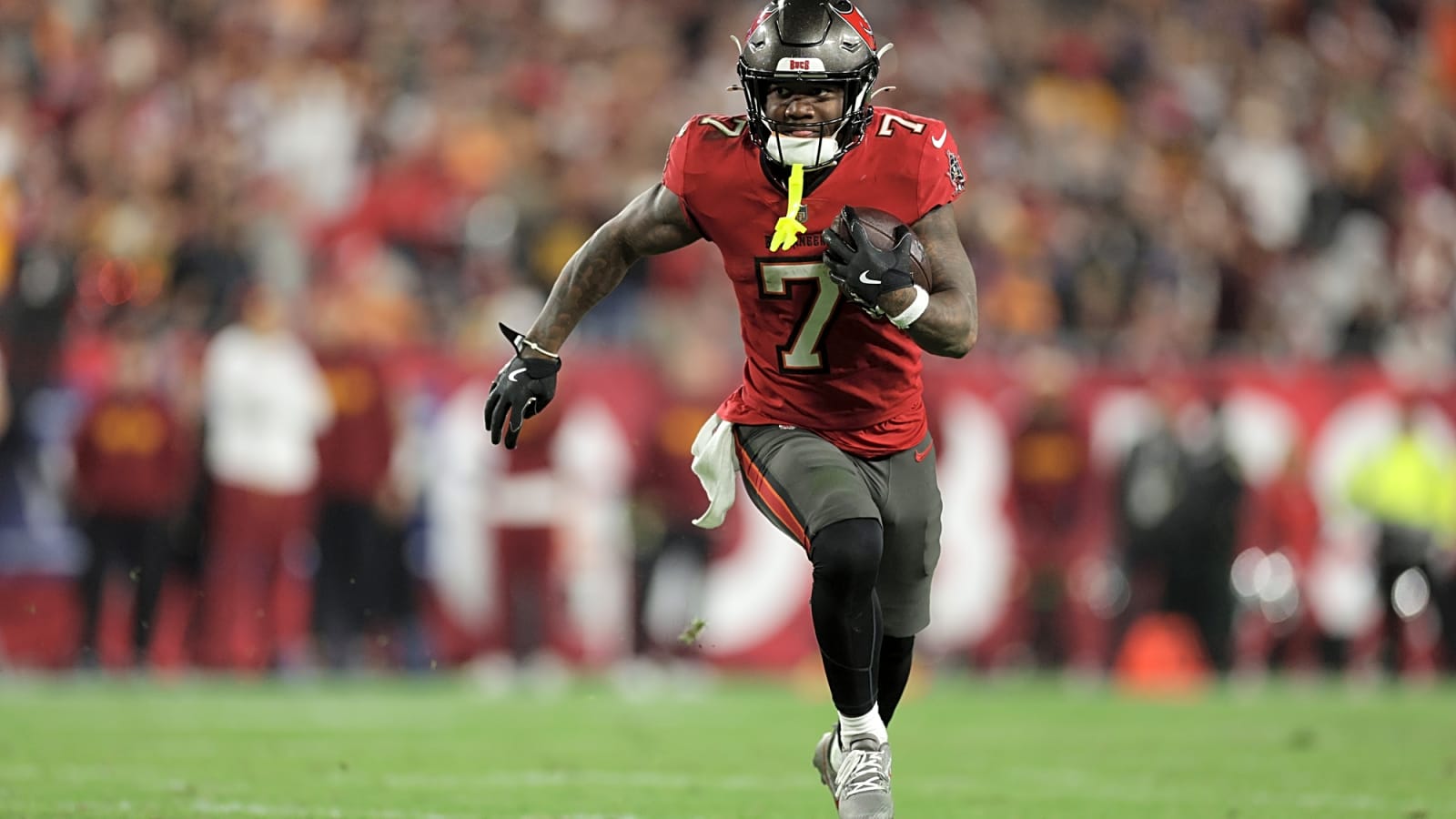
One of the biggest storylines of the 2024 season was the development of the Bucs’ run game. After ranking near the bottom of the league for two consecutive years, Tampa Bay popped for 149 yards per game on the ground, 5.3 yards per rush and +0.04 EPA/rush. All three of those marks were good for top six in the league or better.
There are multiple reasons for this improvement. The emergence of fourth-round pick Bucky Irving was a true breakout that helped fuel the run game. Irving is an incredible talent. He was fifth among qualifying running backs in forced missed tackle rate, eighth in breakaway rate and first in yards after contact per carry. He was a true revelation who won the starting job midway through the season and never looked back.
But in addition to Irving’s coming out party, former offensive coordinator Liam Coen made a critical adjustment to the structure of the run game midway through the year that unlocked the full potential of Irving, the rest of the backs, and the supporting cast altogether.
The Bucs And Mid Zone
Liam Coen, like Dave Canales before him, came to Tampa Bay with dreams of installing a mid-zone-based run game. Mid zone was all the craze in the mid-to-late 2010s. Zone to gap ratios throughout the league were pretty steadily around 60/40. This all flowed from the Kyle Shanahan/Sean McVay offensive philosophies that had permeated throughout most of the league. Canales and Coen, both with ties to that coaching tree, were disciples of this philosophy.
Canales’ first iteration of the mid zone in Tampa Bay in 2023, was … not great. That year the Bucs ran zone concepts 57% of the time. They finished the year dead last in yards per carry and 27th in EPA per carry. The team made two changes on the offensive line, replacing Robert Hainsey at center with Graham Barton, and Aaron Stinnie at left guard with Ben Bredeson.
Coen’s version of mid zone, even with the personnel changes, looked a lot like Canales’ implementation. The gap/zone split for the first four weeks of the 2024 season was 54/46. Irving, Rachaad White and Sean Tucker combined to average 4.2 yards per carry and -0.07 EPA/rush. But looking below the surface, those three averaged 7.2 yards per carry on gap runs. Their counter game was particularly lethal. This was something we at Pewter Report noted at the time, but it’s worth revisiting.
The Switch
That’s where Liam Coen started to make a conscious move from zone to a more power/gap-based system. From Week 5 through the end of the season the Bucs ran gap on 57% of their designed runs. The difference in efficiency was incredible. Their yards per carry spiked to 5.3 and their EPA/run was a positive 0.06.
Those counter runs were … exceptional. Tampa Bay was the best counter team in the NFL in 2024, averaging 8.0 yards per carry.
The Bucs becoming one of the best gap teams in football once they started building the rushing attack around Bucky Irving’s skills (vision, shiftiness, burst) was one of my favorite storylines of last year
TB led the league in EPA/play + success rate on counter runs … pic.twitter.com/OmBHs4ds0b
— Mina Kimes (@minakimes) July 3, 2025
Now while Mina Kimes notes the switch was built around Bucky Irving, it can be argued that the adjustment was for the benefit of the entire offense. Specifically, the offensive line.
You see, the success on counter was not a new phenomenon that started with – or because of – Irving. Their yards per carry in 2023 on gap runs was 18% better than their zone runs. And from 2022-2023 Rachaad White’s yards/car was 52% higher, yac/car was 24% higher and EPA/play was 72% higher on gap runs than on zone runs.
And that carried over into 2024. Here is White’s efficiency last year on zone vs. gap.
Zone
2.9 yards/carry
9% MTF
2.2 yac/car
-0.17 EPA/play
Gap
6.5 yards/carry
15% MTF
4.6 yac/car
+0.12 EPA/play
White was clearly better in the gap-based attack just as much, if not more, than Irving.
The Impact On The Rest of the Offense
With both Bucky Irving and Rachaad White producing better on gap runs, and this showing over multiple seasons, it stands to reason that this is a rising tide lifts all boats situation. And that tide that is rising is the offensive line.
Ben Bredeson had the best year of his career in 2024, pinning nose tackles and pulling around to seal edges on counters and lead/power runs. Cody Mauch and Luke Goedeke formed one of the most destructive double teams you can find. Mauch has improved his anchor to stone most any interior defender and Goedeke delivers the finishing move to create holes the size of the Grand Canyon.
There really isn’t anything Tristan Wirfs cannot do. He has the power to knock guys out of their gaps as a bump and climb guy. But on the move, he is truly special. And Graham Barton had some really special flashes of strain, double and climb.
And Cade Otton – Otton was a revelation as a blocking tight end. In 2023 Otton was asked to run frontside of those mid zone plays having to sustain blocks laterally. It didn’t match his skillset well and he and the run game as a whole suffered.
As a matter of fact, mid zone just didn’t fit any of the Bucs offensive line well. That style of offense requires every player to move in unison. You could not pinpoint a single issue that plagued their efforts.
In addition to Otton struggling as a lateral blocker, Wirfs and Bredeson would often step on or over each other, Barton was slow to get from snap to step. The line had issues executing at almost every juncture of implementation.
But on those gap runs there was less moving in unison across a lateral plane and more point and smash for each player. Otton continued to block on the move, but now as a puller where he could target and collide. Mauch and Goedeke were able to maul to a point of attack and Bredeson could use angles to gain the upper hand. It all gelled in the best of ways leading to unprecedented success for the unit which helped propel the overall offense to one of the best in the league.
[/fusion_text][/fusion_builder_column][/fusion_builder_row][/fusion_builder_container]More must-reads:
- Patriots owner Robert Kraft offers rare praise for former HC Bill Belichick
- Chiefs' Patrick Mahomes reveals feelings on 18-game NFL regular season
- The 'Total touchdown leaders by NFL season since 2000' quiz
Breaking News
Trending News
Customize Your Newsletter
 +
+
Get the latest news and rumors, customized to your favorite sports and teams. Emailed daily. Always free!








